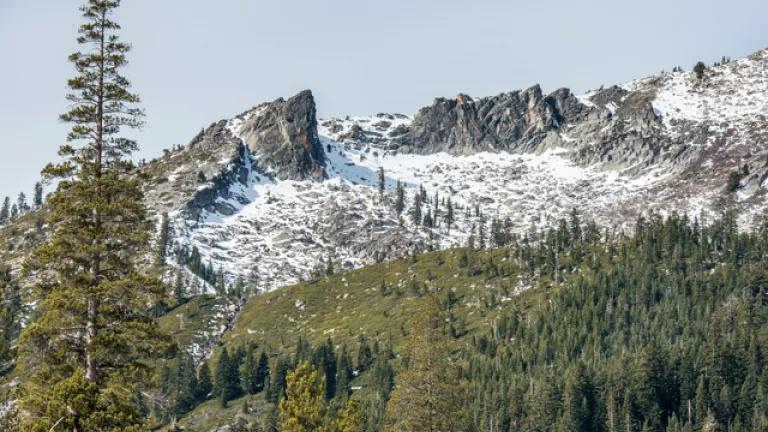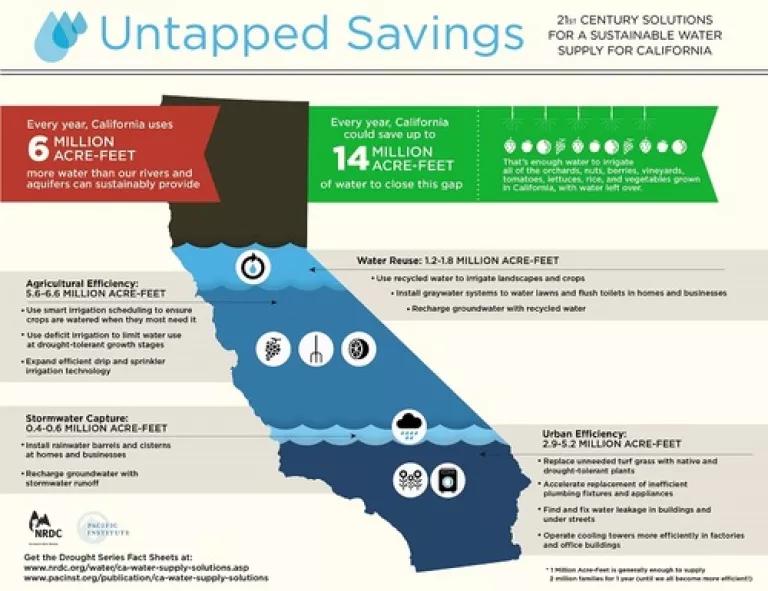
California likes to be the first at a lot of things and in the process, pave the way for other states. We're continuing to break records this year--but not in ways we want. It's been a warm, record-breaking winter for California, and we're going to shatter another record when the abysmal results of the upcoming April snow survey are released.
We're now in our fourth consecutive year of drought--with more than 93 percent of the state facing severe to exceptional drought. The snow survey is an important indicator of how much water will flow into streams and rivers during the upcoming "dry" summer and fall months, and this year's survey is expected to show that we have a shockingly low amount of snow--shattering the previous low on record.
- Conditions during February 2015 snow survey at Phillips Station (Photo credit: Florence Low | CA DWR)
The April snow survey is particularly important because it generally represents when snowpack is at its peak--what we have at the beginning of April typically is all we're going to get. And this year's April snowpack is especially sobering because it will be the lowest since official state records began in 1930.
Exceptionally warm temperatures are partially to blame for the nearly non-existent snowpack. This past winter was nearly 5 degrees hotter than average, setting a new temperature record after we've already seen a string of record high temperatures broken. February was the hottest February on record, and 2014 was the hottest calendar year in the state's recorded history.
While the rain that we have seen this winter has helped water reservoir levels rebound slightly, snowpack--especially in the Sierra Nevada mountain range--is a critical source of water for California. This snowpack normally stores 15 million acre-feet of water and provides one-third of the water used by cities and farms each year.
Unfortunately, climate change is likely to increase the frequency of warmer winters and low snowpack. Scientists project that by the end of the century, warmer temperatures could lead to a 70 to 90 percent reduction in spring snowpack as more precipitation falls as rain instead of snow and snowpack melts earlier in the year, changing streamflow patterns. These shifts in runoff lead to higher flood risks in the winter while also reducing the water available in the summer and fall to meet agricultural, industrial, and municipal water needs.
The historically-low snowpack and unprecedented drought conditions underscore the need for all Californians to take stronger action to conserve water today. In recent months, urban water conservation efforts have declined, reiterating the need for bold new action to stretch dwindling water supplies during the drought. For example, expanding turf removal programs (since outdoor landscaping typically accounts for more than 50% of residential water use), increasing rebates and tax incentives for water-efficient appliances like clothes washers, and replacing water mains to avoid costly leaks are all strategies that can and should be implemented to further conserve water.
The likely impacts of climate change on California's water supplies demonstrate that we need long-term solutions in order to sustain our farms, cities, and environment. A 2014 analysis by NRDC and the Pacific Institute (Untapped Potential) demonstrates that dramatically increasing investments in cost-effective and sustainable local water supplies like water recycling, stormwater capture, improved irrigation and urban water use efficiency, and groundwater cleanup and conjunctive use projects can create millions of acre feet of new water supplies.

If there is one enlightening takeaway from the drought, it's that water agencies that have developed a diverse portfolio of water supplies--as opposed to relying solely on a single source of water like the Delta or groundwater--are better positioned to handle the drought. Many of these local water supply solutions are cost-effective (for instance, recycled water from the Orange County Groundwater Replenishment Project costs less than water imported from the Bay-Delta), are more drought resistant than water from the Colorado River or Bay-Delta (both of which have been severely affected by long-term drought conditions), and can help Southern California and other communities reduce reliance on imported water supplies while creating local jobs.
Likewise, in the agricultural community, irrigation districts that have taken steps to plan and prepare for dry times like this one have been better able to weather the drought. California's large irrigation districts are required to update their management plans--including their plans to deal with climate change--by the end of the year. Unfortunately, when plans were due in 2012, just a fraction of the districts met the deadline even though proactively preparing for climate change makes them more resilient to drought. For example, South San Joaquin Irrigation District (SSJID) upgraded a portion of its infrastructure in 2012 to incorporate some of the efficient irrigation techniques described in our Untapped Potential report, and as a result, significantly cut its demand for water. SSJID is now doubling down on that forward-looking investment and is looking to update additional areas, including its main canal.
The water challenges that California currently faces will likely grow worse due to climate change, but the actions that we take today to invest in cost-effective and sustainable solutions will better position us to handle those challenges looming in the years ahead. This year's record low snowpack is a dire call for communities to start making those important investments now.
